Child Psychology Project: Exploring Rachel's Needs and Development
VerifiedAdded on 2022/08/18
|9
|2103
|17
Project
AI Summary
This project is a comprehensive analysis of Rachel's case study, focusing on her developmental needs within the framework of child psychology. The assignment delves into Rachel's attachment issues, cognitive development, and the impact of her environment, drawing upon the theories of Bowlby, Piaget, and Erikson. It assesses Rachel's unmet needs, particularly in the context of her relationship with her mother and the benefits she receives from her father's care. The project explores the importance of play, interpersonal skills, and healthy contexts for child development, offering strategies and treatments to support Rachel's well-being. These include recommendations for her parents, potential interventions, and contextual supports like family agencies and mental health services. The analysis includes a reflection on the student's personal beliefs, points of agreement and disagreement, and recommendations for policy and practice, providing a holistic understanding of Rachel's situation and potential interventions.
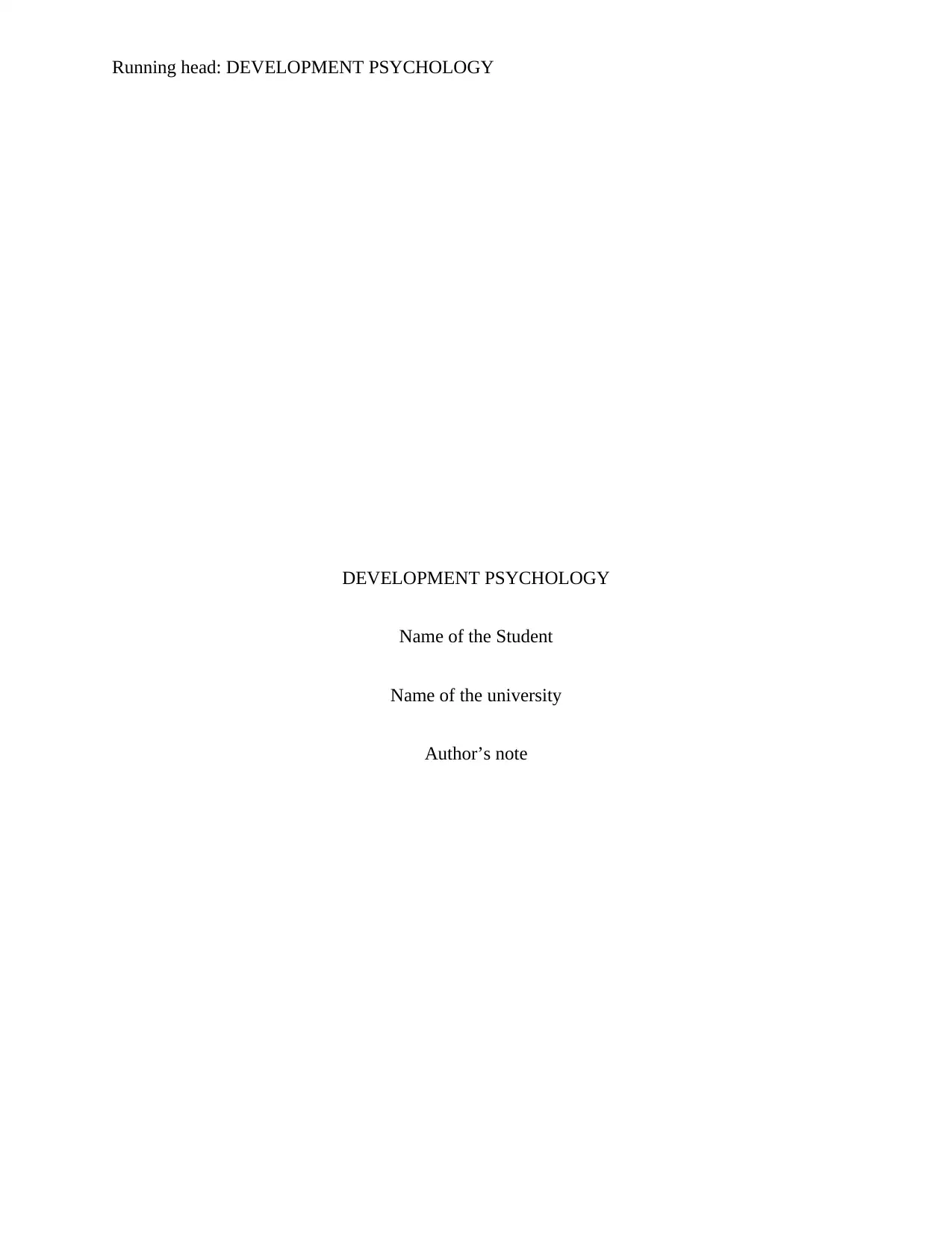
Running head: DEVELOPMENT PSYCHOLOGY
DEVELOPMENT PSYCHOLOGY
Name of the Student
Name of the university
Author’s note
DEVELOPMENT PSYCHOLOGY
Name of the Student
Name of the university
Author’s note
Paraphrase This Document
Need a fresh take? Get an instant paraphrase of this document with our AI Paraphraser
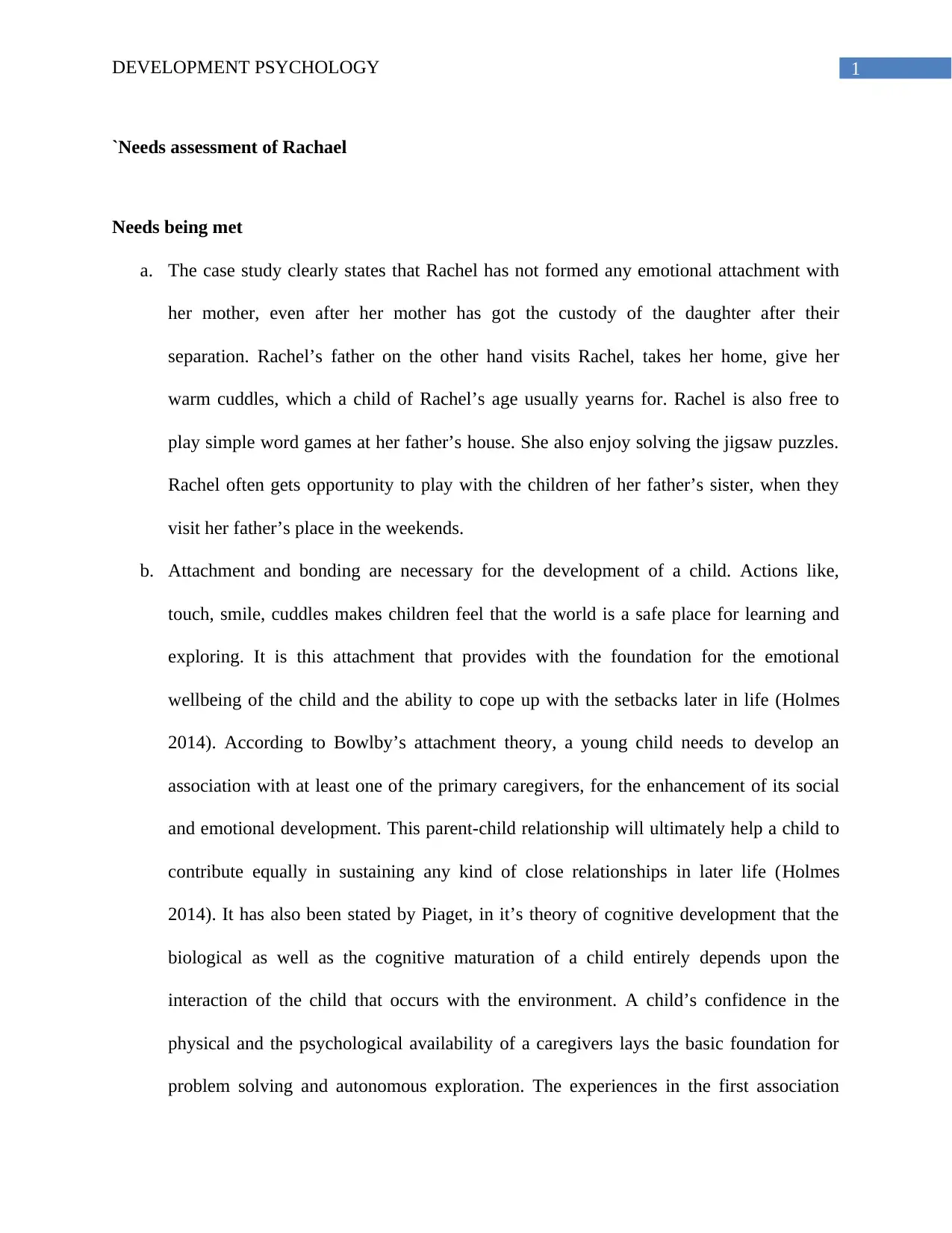
1DEVELOPMENT PSYCHOLOGY
`Needs assessment of Rachael
Needs being met
a. The case study clearly states that Rachel has not formed any emotional attachment with
her mother, even after her mother has got the custody of the daughter after their
separation. Rachel’s father on the other hand visits Rachel, takes her home, give her
warm cuddles, which a child of Rachel’s age usually yearns for. Rachel is also free to
play simple word games at her father’s house. She also enjoy solving the jigsaw puzzles.
Rachel often gets opportunity to play with the children of her father’s sister, when they
visit her father’s place in the weekends.
b. Attachment and bonding are necessary for the development of a child. Actions like,
touch, smile, cuddles makes children feel that the world is a safe place for learning and
exploring. It is this attachment that provides with the foundation for the emotional
wellbeing of the child and the ability to cope up with the setbacks later in life (Holmes
2014). According to Bowlby’s attachment theory, a young child needs to develop an
association with at least one of the primary caregivers, for the enhancement of its social
and emotional development. This parent-child relationship will ultimately help a child to
contribute equally in sustaining any kind of close relationships in later life (Holmes
2014). It has also been stated by Piaget, in it’s theory of cognitive development that the
biological as well as the cognitive maturation of a child entirely depends upon the
interaction of the child that occurs with the environment. A child’s confidence in the
physical and the psychological availability of a caregivers lays the basic foundation for
problem solving and autonomous exploration. The experiences in the first association
`Needs assessment of Rachael
Needs being met
a. The case study clearly states that Rachel has not formed any emotional attachment with
her mother, even after her mother has got the custody of the daughter after their
separation. Rachel’s father on the other hand visits Rachel, takes her home, give her
warm cuddles, which a child of Rachel’s age usually yearns for. Rachel is also free to
play simple word games at her father’s house. She also enjoy solving the jigsaw puzzles.
Rachel often gets opportunity to play with the children of her father’s sister, when they
visit her father’s place in the weekends.
b. Attachment and bonding are necessary for the development of a child. Actions like,
touch, smile, cuddles makes children feel that the world is a safe place for learning and
exploring. It is this attachment that provides with the foundation for the emotional
wellbeing of the child and the ability to cope up with the setbacks later in life (Holmes
2014). According to Bowlby’s attachment theory, a young child needs to develop an
association with at least one of the primary caregivers, for the enhancement of its social
and emotional development. This parent-child relationship will ultimately help a child to
contribute equally in sustaining any kind of close relationships in later life (Holmes
2014). It has also been stated by Piaget, in it’s theory of cognitive development that the
biological as well as the cognitive maturation of a child entirely depends upon the
interaction of the child that occurs with the environment. A child’s confidence in the
physical and the psychological availability of a caregivers lays the basic foundation for
problem solving and autonomous exploration. The experiences in the first association
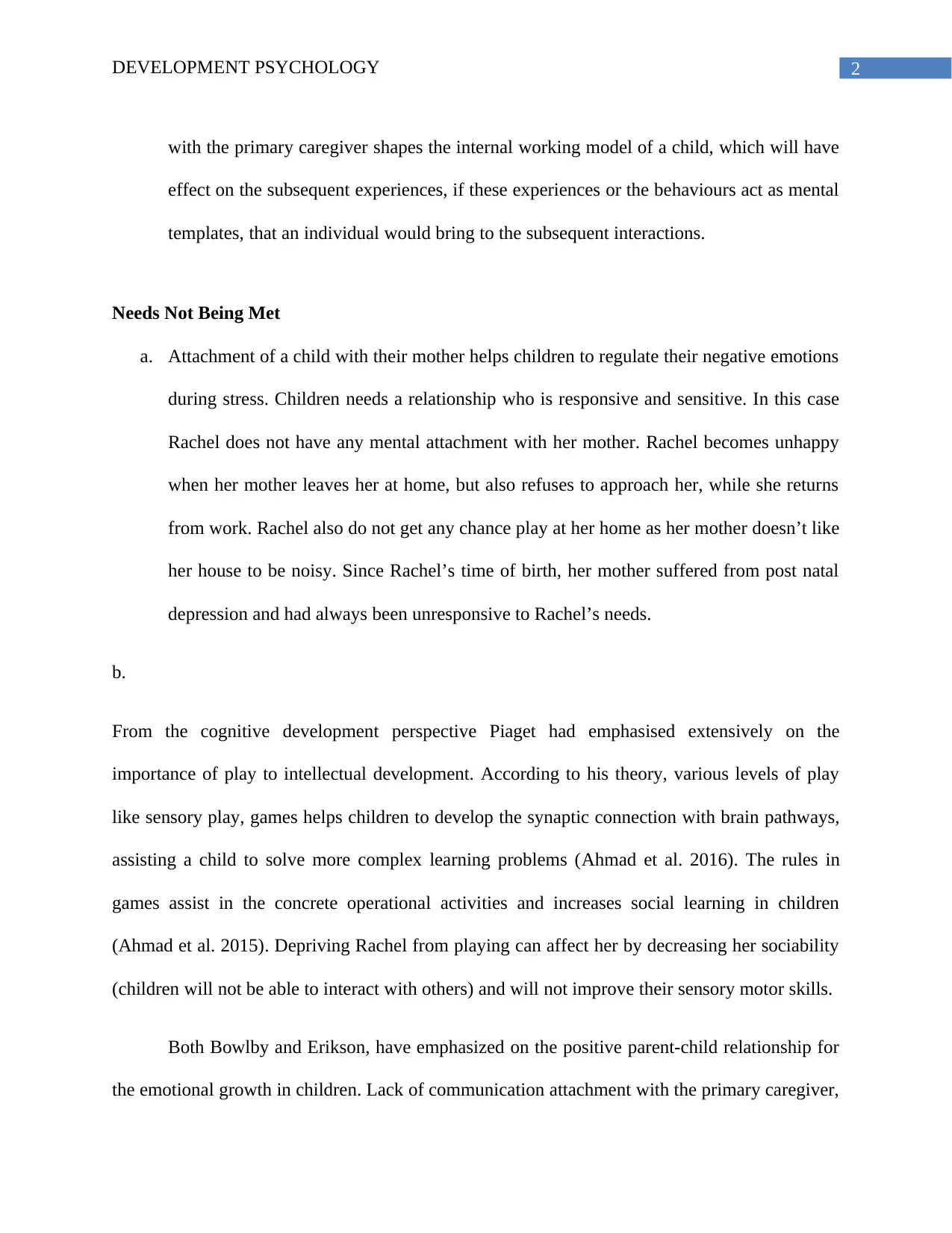
2DEVELOPMENT PSYCHOLOGY
with the primary caregiver shapes the internal working model of a child, which will have
effect on the subsequent experiences, if these experiences or the behaviours act as mental
templates, that an individual would bring to the subsequent interactions.
Needs Not Being Met
a. Attachment of a child with their mother helps children to regulate their negative emotions
during stress. Children needs a relationship who is responsive and sensitive. In this case
Rachel does not have any mental attachment with her mother. Rachel becomes unhappy
when her mother leaves her at home, but also refuses to approach her, while she returns
from work. Rachel also do not get any chance play at her home as her mother doesn’t like
her house to be noisy. Since Rachel’s time of birth, her mother suffered from post natal
depression and had always been unresponsive to Rachel’s needs.
b.
From the cognitive development perspective Piaget had emphasised extensively on the
importance of play to intellectual development. According to his theory, various levels of play
like sensory play, games helps children to develop the synaptic connection with brain pathways,
assisting a child to solve more complex learning problems (Ahmad et al. 2016). The rules in
games assist in the concrete operational activities and increases social learning in children
(Ahmad et al. 2015). Depriving Rachel from playing can affect her by decreasing her sociability
(children will not be able to interact with others) and will not improve their sensory motor skills.
Both Bowlby and Erikson, have emphasized on the positive parent-child relationship for
the emotional growth in children. Lack of communication attachment with the primary caregiver,
with the primary caregiver shapes the internal working model of a child, which will have
effect on the subsequent experiences, if these experiences or the behaviours act as mental
templates, that an individual would bring to the subsequent interactions.
Needs Not Being Met
a. Attachment of a child with their mother helps children to regulate their negative emotions
during stress. Children needs a relationship who is responsive and sensitive. In this case
Rachel does not have any mental attachment with her mother. Rachel becomes unhappy
when her mother leaves her at home, but also refuses to approach her, while she returns
from work. Rachel also do not get any chance play at her home as her mother doesn’t like
her house to be noisy. Since Rachel’s time of birth, her mother suffered from post natal
depression and had always been unresponsive to Rachel’s needs.
b.
From the cognitive development perspective Piaget had emphasised extensively on the
importance of play to intellectual development. According to his theory, various levels of play
like sensory play, games helps children to develop the synaptic connection with brain pathways,
assisting a child to solve more complex learning problems (Ahmad et al. 2016). The rules in
games assist in the concrete operational activities and increases social learning in children
(Ahmad et al. 2015). Depriving Rachel from playing can affect her by decreasing her sociability
(children will not be able to interact with others) and will not improve their sensory motor skills.
Both Bowlby and Erikson, have emphasized on the positive parent-child relationship for
the emotional growth in children. Lack of communication attachment with the primary caregiver,
⊘ This is a preview!⊘
Do you want full access?
Subscribe today to unlock all pages.

Trusted by 1+ million students worldwide
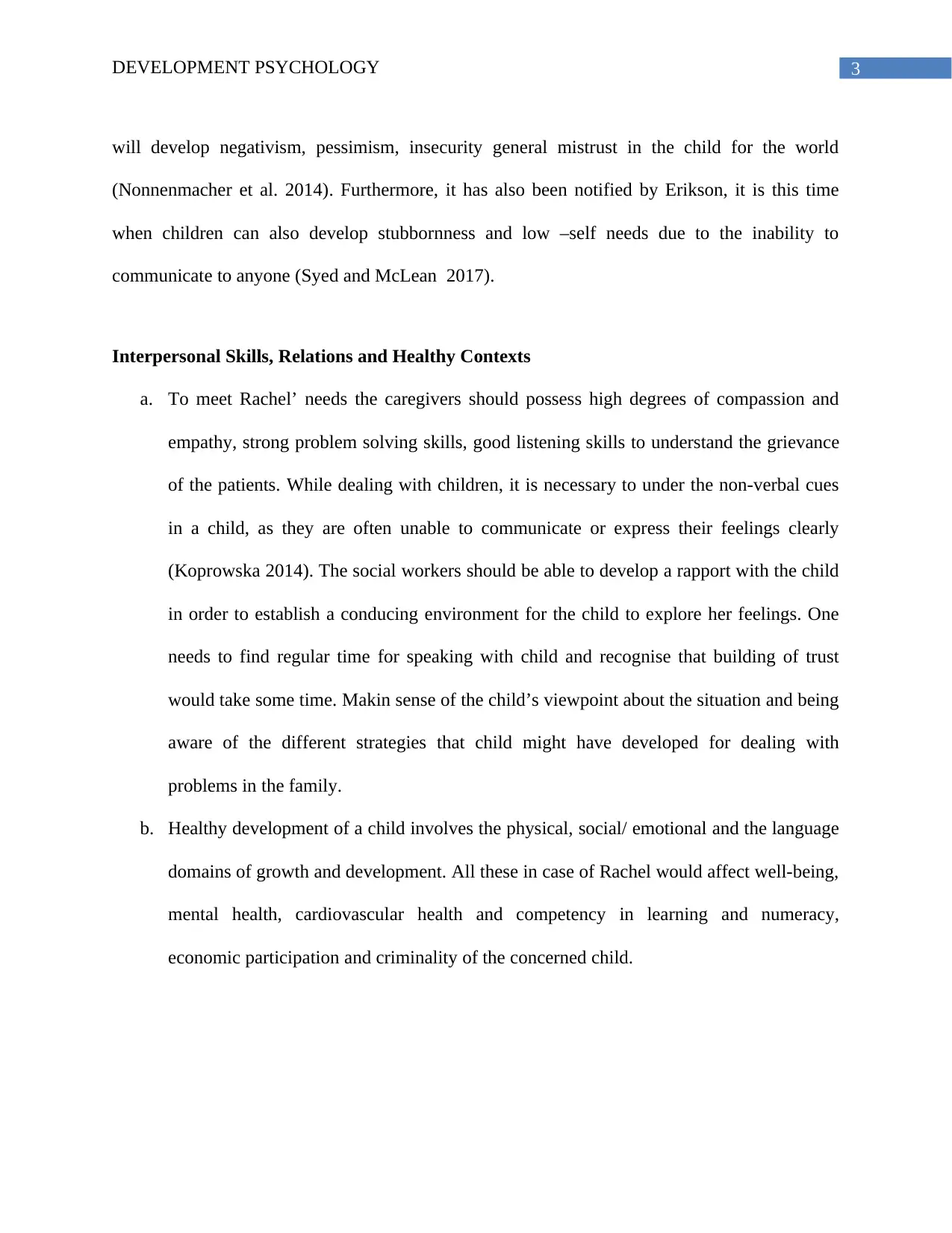
3DEVELOPMENT PSYCHOLOGY
will develop negativism, pessimism, insecurity general mistrust in the child for the world
(Nonnenmacher et al. 2014). Furthermore, it has also been notified by Erikson, it is this time
when children can also develop stubbornness and low –self needs due to the inability to
communicate to anyone (Syed and McLean 2017).
Interpersonal Skills, Relations and Healthy Contexts
a. To meet Rachel’ needs the caregivers should possess high degrees of compassion and
empathy, strong problem solving skills, good listening skills to understand the grievance
of the patients. While dealing with children, it is necessary to under the non-verbal cues
in a child, as they are often unable to communicate or express their feelings clearly
(Koprowska 2014). The social workers should be able to develop a rapport with the child
in order to establish a conducing environment for the child to explore her feelings. One
needs to find regular time for speaking with child and recognise that building of trust
would take some time. Makin sense of the child’s viewpoint about the situation and being
aware of the different strategies that child might have developed for dealing with
problems in the family.
b. Healthy development of a child involves the physical, social/ emotional and the language
domains of growth and development. All these in case of Rachel would affect well-being,
mental health, cardiovascular health and competency in learning and numeracy,
economic participation and criminality of the concerned child.
will develop negativism, pessimism, insecurity general mistrust in the child for the world
(Nonnenmacher et al. 2014). Furthermore, it has also been notified by Erikson, it is this time
when children can also develop stubbornness and low –self needs due to the inability to
communicate to anyone (Syed and McLean 2017).
Interpersonal Skills, Relations and Healthy Contexts
a. To meet Rachel’ needs the caregivers should possess high degrees of compassion and
empathy, strong problem solving skills, good listening skills to understand the grievance
of the patients. While dealing with children, it is necessary to under the non-verbal cues
in a child, as they are often unable to communicate or express their feelings clearly
(Koprowska 2014). The social workers should be able to develop a rapport with the child
in order to establish a conducing environment for the child to explore her feelings. One
needs to find regular time for speaking with child and recognise that building of trust
would take some time. Makin sense of the child’s viewpoint about the situation and being
aware of the different strategies that child might have developed for dealing with
problems in the family.
b. Healthy development of a child involves the physical, social/ emotional and the language
domains of growth and development. All these in case of Rachel would affect well-being,
mental health, cardiovascular health and competency in learning and numeracy,
economic participation and criminality of the concerned child.
Paraphrase This Document
Need a fresh take? Get an instant paraphrase of this document with our AI Paraphraser
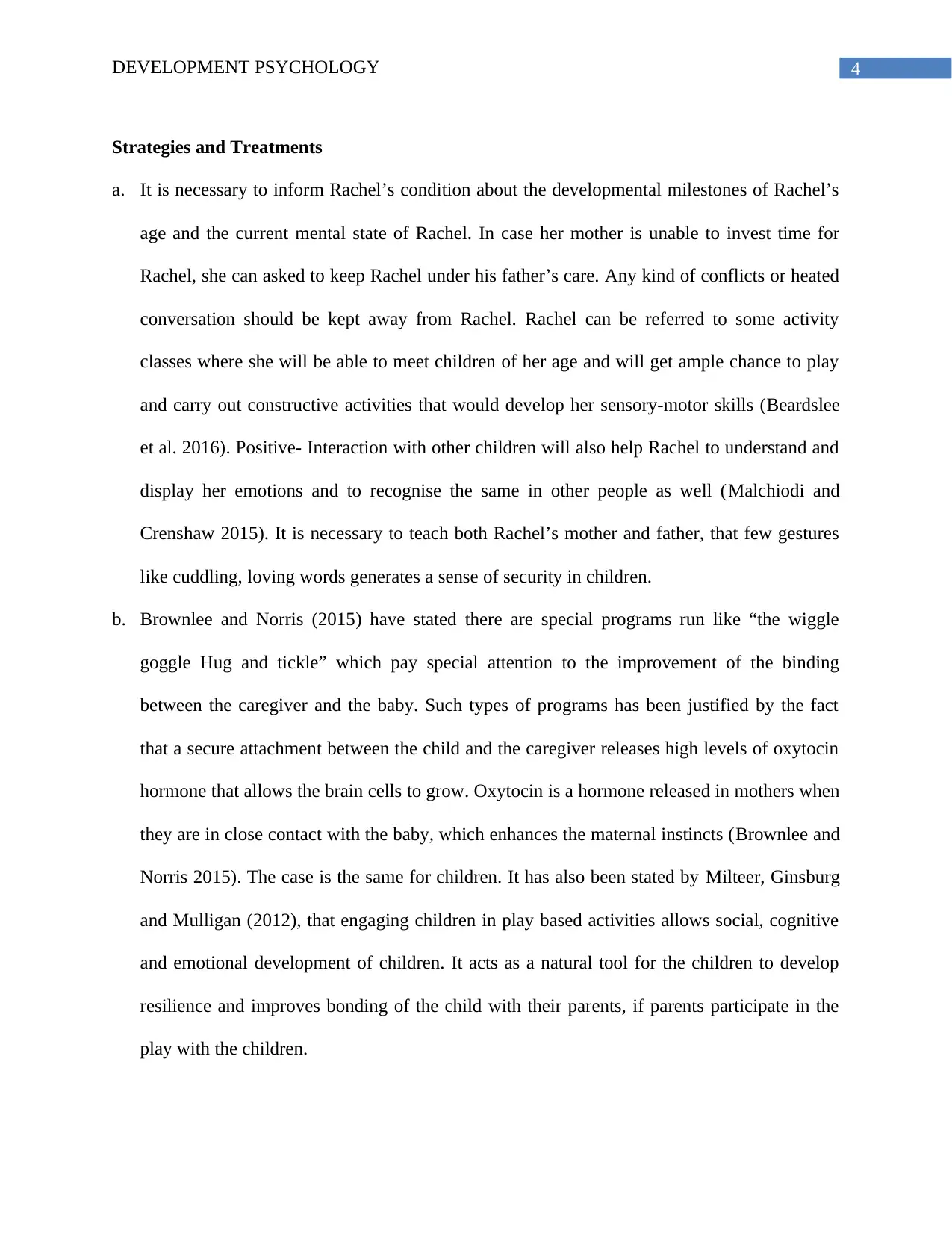
4DEVELOPMENT PSYCHOLOGY
Strategies and Treatments
a. It is necessary to inform Rachel’s condition about the developmental milestones of Rachel’s
age and the current mental state of Rachel. In case her mother is unable to invest time for
Rachel, she can asked to keep Rachel under his father’s care. Any kind of conflicts or heated
conversation should be kept away from Rachel. Rachel can be referred to some activity
classes where she will be able to meet children of her age and will get ample chance to play
and carry out constructive activities that would develop her sensory-motor skills (Beardslee
et al. 2016). Positive- Interaction with other children will also help Rachel to understand and
display her emotions and to recognise the same in other people as well (Malchiodi and
Crenshaw 2015). It is necessary to teach both Rachel’s mother and father, that few gestures
like cuddling, loving words generates a sense of security in children.
b. Brownlee and Norris (2015) have stated there are special programs run like “the wiggle
goggle Hug and tickle” which pay special attention to the improvement of the binding
between the caregiver and the baby. Such types of programs has been justified by the fact
that a secure attachment between the child and the caregiver releases high levels of oxytocin
hormone that allows the brain cells to grow. Oxytocin is a hormone released in mothers when
they are in close contact with the baby, which enhances the maternal instincts (Brownlee and
Norris 2015). The case is the same for children. It has also been stated by Milteer, Ginsburg
and Mulligan (2012), that engaging children in play based activities allows social, cognitive
and emotional development of children. It acts as a natural tool for the children to develop
resilience and improves bonding of the child with their parents, if parents participate in the
play with the children.
Strategies and Treatments
a. It is necessary to inform Rachel’s condition about the developmental milestones of Rachel’s
age and the current mental state of Rachel. In case her mother is unable to invest time for
Rachel, she can asked to keep Rachel under his father’s care. Any kind of conflicts or heated
conversation should be kept away from Rachel. Rachel can be referred to some activity
classes where she will be able to meet children of her age and will get ample chance to play
and carry out constructive activities that would develop her sensory-motor skills (Beardslee
et al. 2016). Positive- Interaction with other children will also help Rachel to understand and
display her emotions and to recognise the same in other people as well (Malchiodi and
Crenshaw 2015). It is necessary to teach both Rachel’s mother and father, that few gestures
like cuddling, loving words generates a sense of security in children.
b. Brownlee and Norris (2015) have stated there are special programs run like “the wiggle
goggle Hug and tickle” which pay special attention to the improvement of the binding
between the caregiver and the baby. Such types of programs has been justified by the fact
that a secure attachment between the child and the caregiver releases high levels of oxytocin
hormone that allows the brain cells to grow. Oxytocin is a hormone released in mothers when
they are in close contact with the baby, which enhances the maternal instincts (Brownlee and
Norris 2015). The case is the same for children. It has also been stated by Milteer, Ginsburg
and Mulligan (2012), that engaging children in play based activities allows social, cognitive
and emotional development of children. It acts as a natural tool for the children to develop
resilience and improves bonding of the child with their parents, if parents participate in the
play with the children.
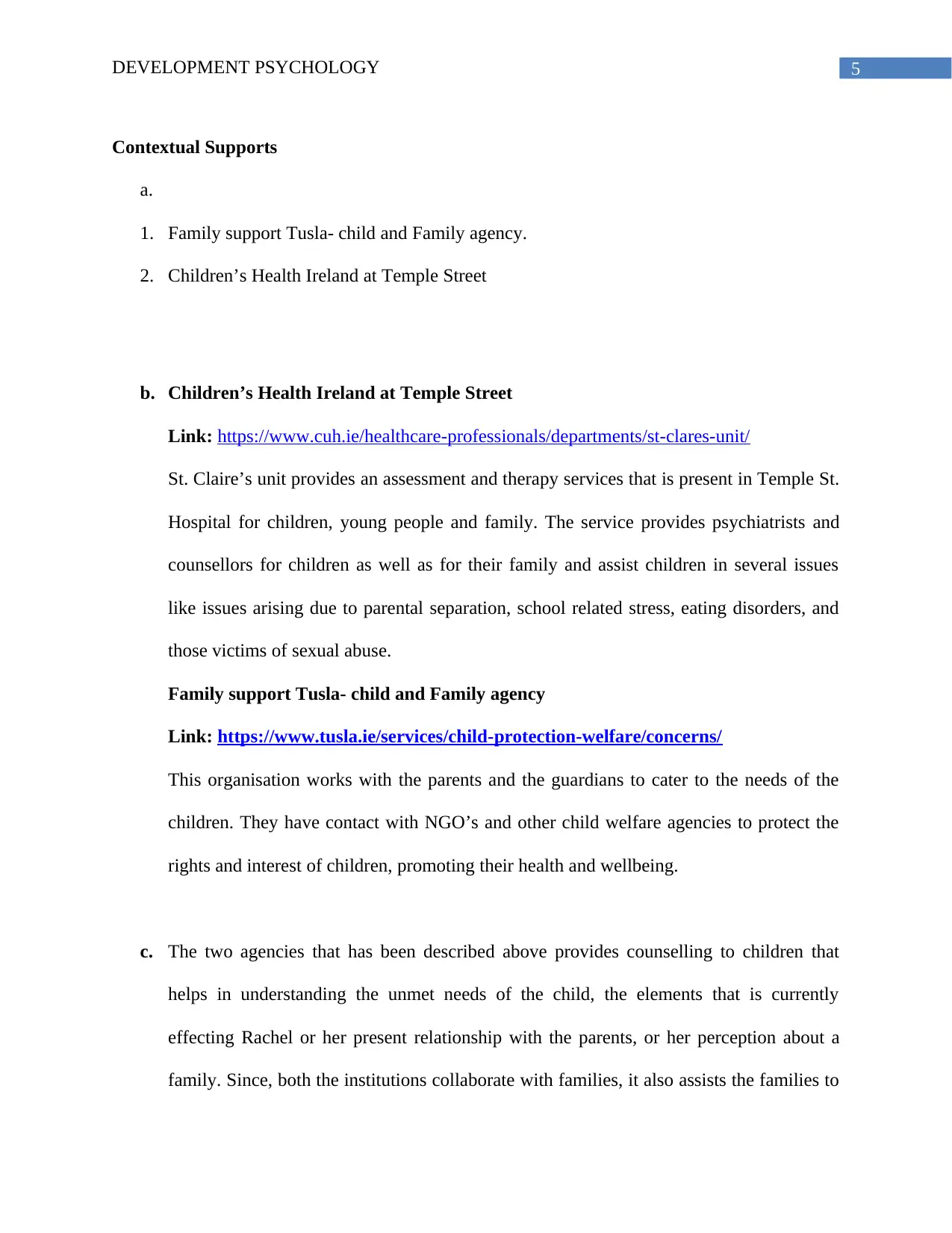
5DEVELOPMENT PSYCHOLOGY
Contextual Supports
a.
1. Family support Tusla- child and Family agency.
2. Children’s Health Ireland at Temple Street
b. Children’s Health Ireland at Temple Street
Link: https://www.cuh.ie/healthcare-professionals/departments/st-clares-unit/
St. Claire’s unit provides an assessment and therapy services that is present in Temple St.
Hospital for children, young people and family. The service provides psychiatrists and
counsellors for children as well as for their family and assist children in several issues
like issues arising due to parental separation, school related stress, eating disorders, and
those victims of sexual abuse.
Family support Tusla- child and Family agency
Link: https://www.tusla.ie/services/child-protection-welfare/concerns/
This organisation works with the parents and the guardians to cater to the needs of the
children. They have contact with NGO’s and other child welfare agencies to protect the
rights and interest of children, promoting their health and wellbeing.
c. The two agencies that has been described above provides counselling to children that
helps in understanding the unmet needs of the child, the elements that is currently
effecting Rachel or her present relationship with the parents, or her perception about a
family. Since, both the institutions collaborate with families, it also assists the families to
Contextual Supports
a.
1. Family support Tusla- child and Family agency.
2. Children’s Health Ireland at Temple Street
b. Children’s Health Ireland at Temple Street
Link: https://www.cuh.ie/healthcare-professionals/departments/st-clares-unit/
St. Claire’s unit provides an assessment and therapy services that is present in Temple St.
Hospital for children, young people and family. The service provides psychiatrists and
counsellors for children as well as for their family and assist children in several issues
like issues arising due to parental separation, school related stress, eating disorders, and
those victims of sexual abuse.
Family support Tusla- child and Family agency
Link: https://www.tusla.ie/services/child-protection-welfare/concerns/
This organisation works with the parents and the guardians to cater to the needs of the
children. They have contact with NGO’s and other child welfare agencies to protect the
rights and interest of children, promoting their health and wellbeing.
c. The two agencies that has been described above provides counselling to children that
helps in understanding the unmet needs of the child, the elements that is currently
effecting Rachel or her present relationship with the parents, or her perception about a
family. Since, both the institutions collaborate with families, it also assists the families to
⊘ This is a preview!⊘
Do you want full access?
Subscribe today to unlock all pages.

Trusted by 1+ million students worldwide
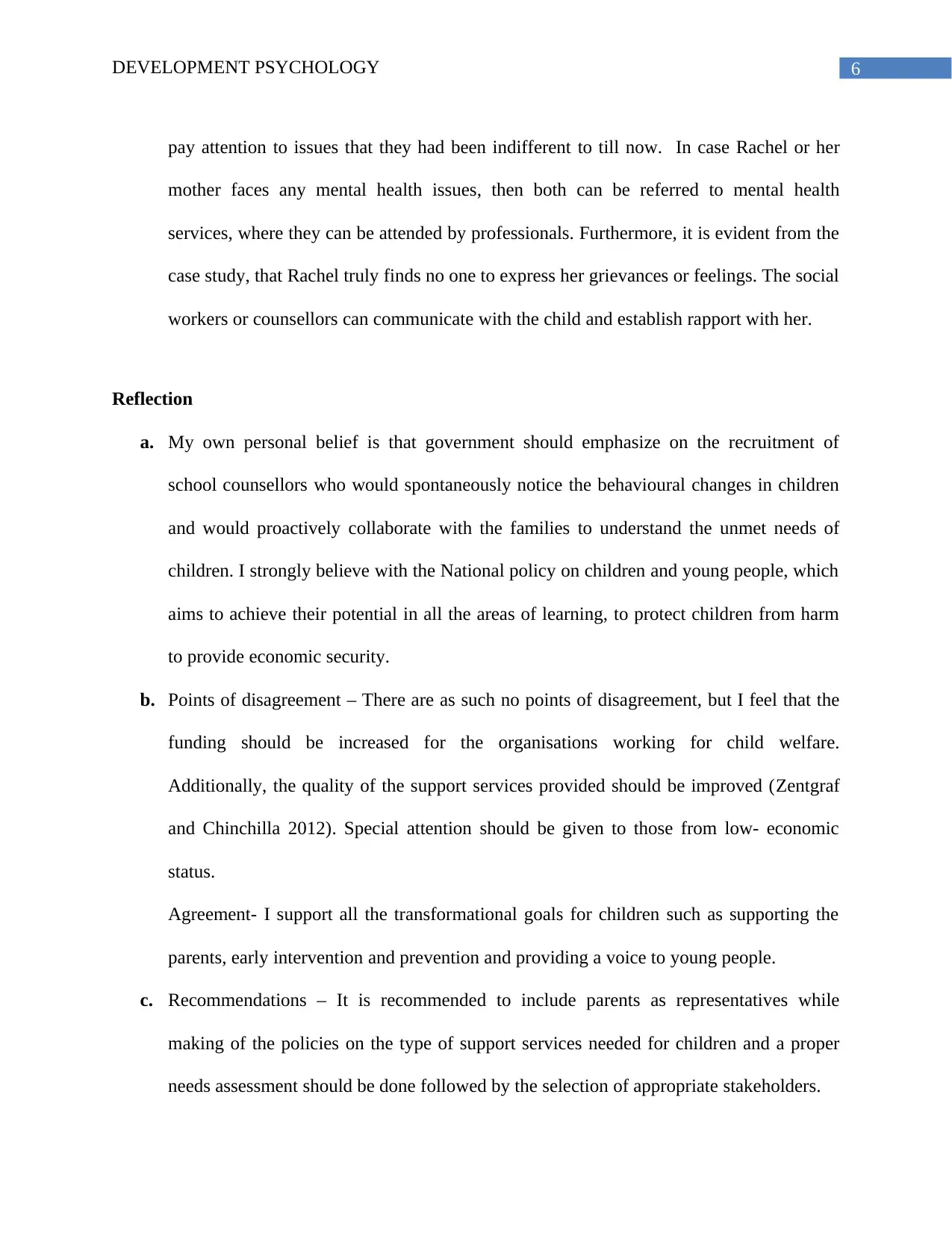
6DEVELOPMENT PSYCHOLOGY
pay attention to issues that they had been indifferent to till now. In case Rachel or her
mother faces any mental health issues, then both can be referred to mental health
services, where they can be attended by professionals. Furthermore, it is evident from the
case study, that Rachel truly finds no one to express her grievances or feelings. The social
workers or counsellors can communicate with the child and establish rapport with her.
Reflection
a. My own personal belief is that government should emphasize on the recruitment of
school counsellors who would spontaneously notice the behavioural changes in children
and would proactively collaborate with the families to understand the unmet needs of
children. I strongly believe with the National policy on children and young people, which
aims to achieve their potential in all the areas of learning, to protect children from harm
to provide economic security.
b. Points of disagreement – There are as such no points of disagreement, but I feel that the
funding should be increased for the organisations working for child welfare.
Additionally, the quality of the support services provided should be improved (Zentgraf
and Chinchilla 2012). Special attention should be given to those from low- economic
status.
Agreement- I support all the transformational goals for children such as supporting the
parents, early intervention and prevention and providing a voice to young people.
c. Recommendations – It is recommended to include parents as representatives while
making of the policies on the type of support services needed for children and a proper
needs assessment should be done followed by the selection of appropriate stakeholders.
pay attention to issues that they had been indifferent to till now. In case Rachel or her
mother faces any mental health issues, then both can be referred to mental health
services, where they can be attended by professionals. Furthermore, it is evident from the
case study, that Rachel truly finds no one to express her grievances or feelings. The social
workers or counsellors can communicate with the child and establish rapport with her.
Reflection
a. My own personal belief is that government should emphasize on the recruitment of
school counsellors who would spontaneously notice the behavioural changes in children
and would proactively collaborate with the families to understand the unmet needs of
children. I strongly believe with the National policy on children and young people, which
aims to achieve their potential in all the areas of learning, to protect children from harm
to provide economic security.
b. Points of disagreement – There are as such no points of disagreement, but I feel that the
funding should be increased for the organisations working for child welfare.
Additionally, the quality of the support services provided should be improved (Zentgraf
and Chinchilla 2012). Special attention should be given to those from low- economic
status.
Agreement- I support all the transformational goals for children such as supporting the
parents, early intervention and prevention and providing a voice to young people.
c. Recommendations – It is recommended to include parents as representatives while
making of the policies on the type of support services needed for children and a proper
needs assessment should be done followed by the selection of appropriate stakeholders.
Paraphrase This Document
Need a fresh take? Get an instant paraphrase of this document with our AI Paraphraser
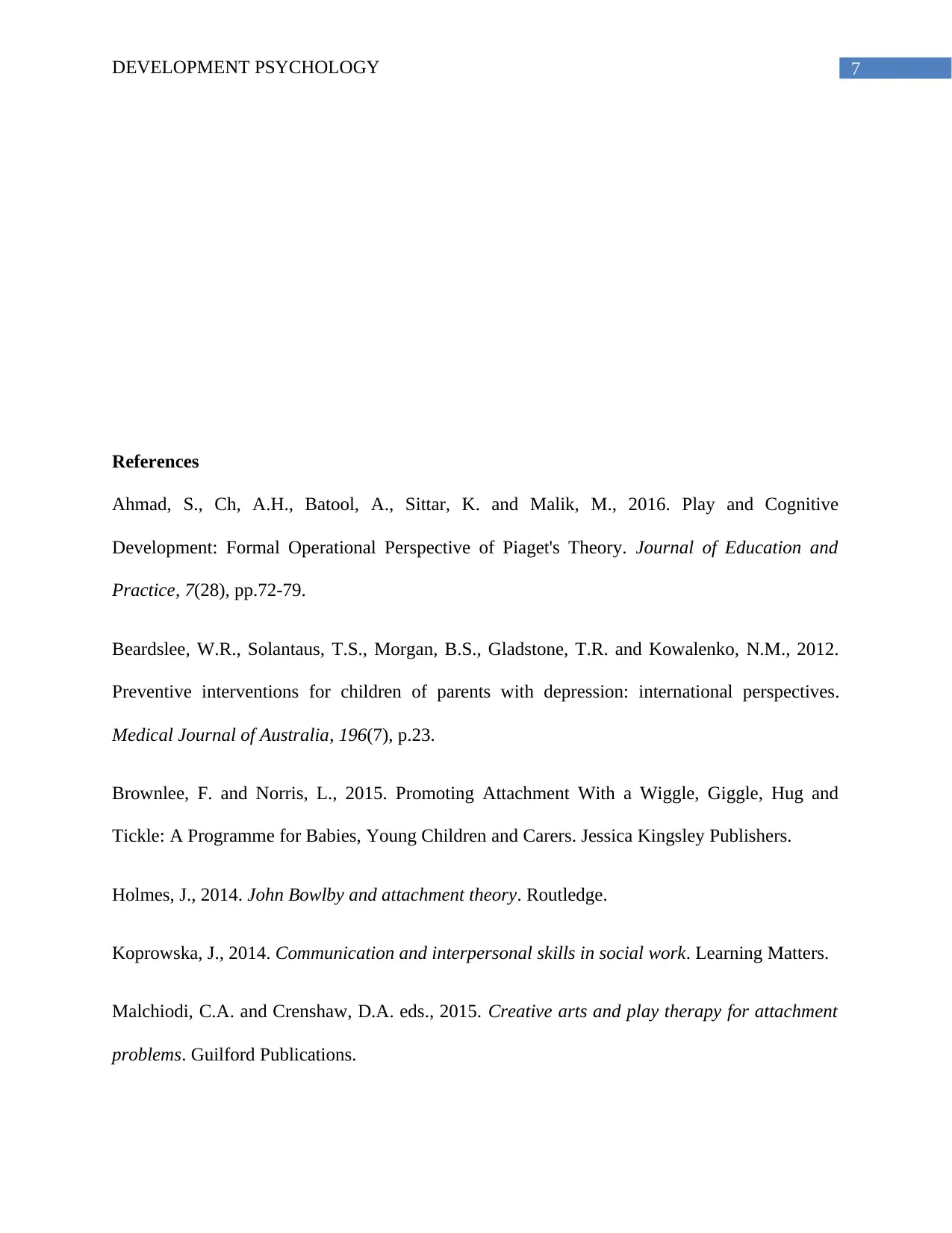
7DEVELOPMENT PSYCHOLOGY
References
Ahmad, S., Ch, A.H., Batool, A., Sittar, K. and Malik, M., 2016. Play and Cognitive
Development: Formal Operational Perspective of Piaget's Theory. Journal of Education and
Practice, 7(28), pp.72-79.
Beardslee, W.R., Solantaus, T.S., Morgan, B.S., Gladstone, T.R. and Kowalenko, N.M., 2012.
Preventive interventions for children of parents with depression: international perspectives.
Medical Journal of Australia, 196(7), p.23.
Brownlee, F. and Norris, L., 2015. Promoting Attachment With a Wiggle, Giggle, Hug and
Tickle: A Programme for Babies, Young Children and Carers. Jessica Kingsley Publishers.
Holmes, J., 2014. John Bowlby and attachment theory. Routledge.
Koprowska, J., 2014. Communication and interpersonal skills in social work. Learning Matters.
Malchiodi, C.A. and Crenshaw, D.A. eds., 2015. Creative arts and play therapy for attachment
problems. Guilford Publications.
References
Ahmad, S., Ch, A.H., Batool, A., Sittar, K. and Malik, M., 2016. Play and Cognitive
Development: Formal Operational Perspective of Piaget's Theory. Journal of Education and
Practice, 7(28), pp.72-79.
Beardslee, W.R., Solantaus, T.S., Morgan, B.S., Gladstone, T.R. and Kowalenko, N.M., 2012.
Preventive interventions for children of parents with depression: international perspectives.
Medical Journal of Australia, 196(7), p.23.
Brownlee, F. and Norris, L., 2015. Promoting Attachment With a Wiggle, Giggle, Hug and
Tickle: A Programme for Babies, Young Children and Carers. Jessica Kingsley Publishers.
Holmes, J., 2014. John Bowlby and attachment theory. Routledge.
Koprowska, J., 2014. Communication and interpersonal skills in social work. Learning Matters.
Malchiodi, C.A. and Crenshaw, D.A. eds., 2015. Creative arts and play therapy for attachment
problems. Guilford Publications.
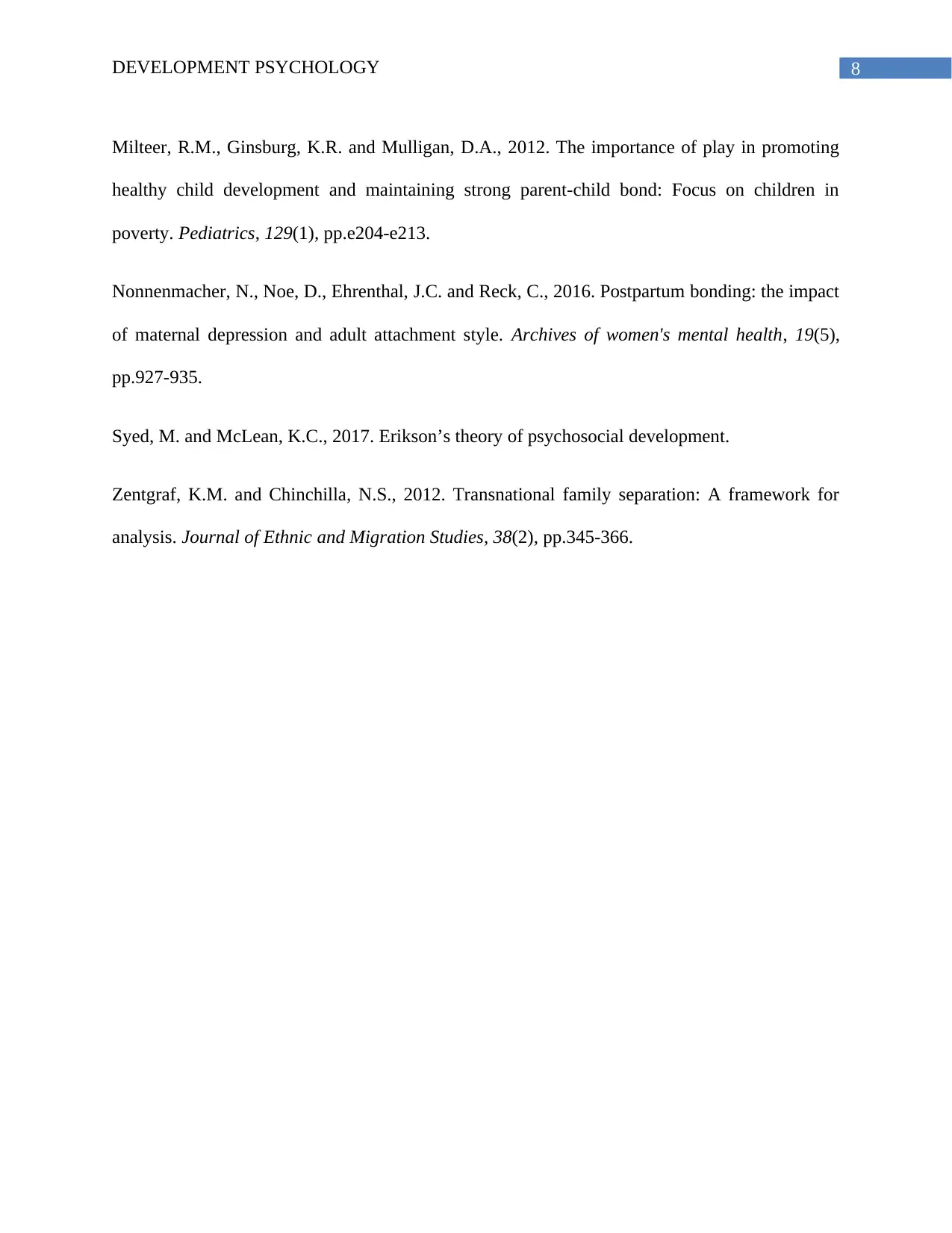
8DEVELOPMENT PSYCHOLOGY
Milteer, R.M., Ginsburg, K.R. and Mulligan, D.A., 2012. The importance of play in promoting
healthy child development and maintaining strong parent-child bond: Focus on children in
poverty. Pediatrics, 129(1), pp.e204-e213.
Nonnenmacher, N., Noe, D., Ehrenthal, J.C. and Reck, C., 2016. Postpartum bonding: the impact
of maternal depression and adult attachment style. Archives of women's mental health, 19(5),
pp.927-935.
Syed, M. and McLean, K.C., 2017. Erikson’s theory of psychosocial development.
Zentgraf, K.M. and Chinchilla, N.S., 2012. Transnational family separation: A framework for
analysis. Journal of Ethnic and Migration Studies, 38(2), pp.345-366.
Milteer, R.M., Ginsburg, K.R. and Mulligan, D.A., 2012. The importance of play in promoting
healthy child development and maintaining strong parent-child bond: Focus on children in
poverty. Pediatrics, 129(1), pp.e204-e213.
Nonnenmacher, N., Noe, D., Ehrenthal, J.C. and Reck, C., 2016. Postpartum bonding: the impact
of maternal depression and adult attachment style. Archives of women's mental health, 19(5),
pp.927-935.
Syed, M. and McLean, K.C., 2017. Erikson’s theory of psychosocial development.
Zentgraf, K.M. and Chinchilla, N.S., 2012. Transnational family separation: A framework for
analysis. Journal of Ethnic and Migration Studies, 38(2), pp.345-366.
⊘ This is a preview!⊘
Do you want full access?
Subscribe today to unlock all pages.

Trusted by 1+ million students worldwide
1 out of 9
Related Documents
Your All-in-One AI-Powered Toolkit for Academic Success.
+13062052269
info@desklib.com
Available 24*7 on WhatsApp / Email
![[object Object]](/_next/static/media/star-bottom.7253800d.svg)
Unlock your academic potential
Copyright © 2020–2025 A2Z Services. All Rights Reserved. Developed and managed by ZUCOL.





